The Sphingidae of
Alberta

Ceratomia undulosa Edmonton, Alberta, courtesy of Evie
Uretsky
N.B., the files are not linked back to this page.
To return to this index, simply use your browser back button.
This website is designed and maintained by Bill Oehlke. Please send sightings (date, location, species) and/or images to Bill.
Teacher Kathy Anderson and her class at Woking School in Woking, northern Alberta, report a sighting of Smerinthus cerisyi May 11, 2006.
To aid with identifications of adult moths a thumbnail checklist has been added (August 13, 2007) to the bottom half of this page.
To aid with identifications of caterpillars a thumbnail checklist has been added, August 28, 2007.
Click on the link: Alberta Sphingidae Larvae.
Sphinginae subfamily
Sphingini tribe:
| Smerinthini Tribe:
|
|
List provided by Alberta Lepidopterists' Guild
courtesy of Gary Anweiler, Edmonton, Alberta, Canada.
I have added Ceratomia amyntor based on larval image sent to me from Drumhellar, courtesy of Burt and Shirley Krull via Sue Brooks.
Felix Sperling writes, "I just found a good example of how our University of Alberta Virtual Museum can be useful for doing historical searches.
"A colleague gave me an obituary from the London Times for George Salt, who died in England Feb. 17th, 2003, aged 99. George Salt grew
up in Calgary and attended the University of Alberta. After time at Harvard, and much travel and research around the world, he ended up
as Reader in Animal Ecology at Cambridge University, doing classic research on insect parasites along the way.
"A search of our Virtual Museum site, using "Salt, George" from the list of collectors in the specimen search function, shows that we
have databased about 60 specimens, from 39 species, in the University of Alberta Strickland Museum that were collected by George Salt. Most
are lepidoptera, including lots of moths, but also one beetle, and most are from Calgary during 1919 to 1922, when he would have been 15-18 years old.
"Check it out! Notice that if you click on the blue "Collector" above the box in the specimen search that allows you to search for
collectors, then you will get an alphabetized list of all collectors.
"Felix Sperling
"ps: If any of you have a website link to the Virtual Museum page, could you please change it to the url above! This new internet
address will help us to make the Virtual Museum searchable via Google. However, before the Google Crawler can be enticed into
indexing our species pages, we need to have as many links as possible to the site above from other web pages. Thanks!"
I visited the Museum's data base and find it excellent for finding info about species flight times and local distributions.
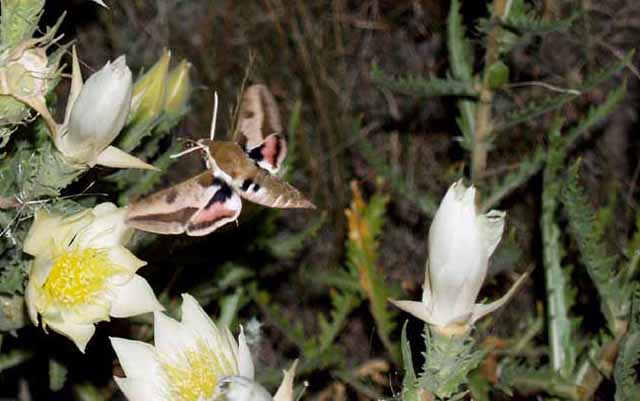
Hyles euphorbiae Lethbridge, Alberta, August 6, 2006,
courtesy of Bruce and Marilyn Bates
Bruce and Marilyn write, "This moth was hovering around an Eveningstar plant. Just thought I'd drop a line to say we have these
moths and plants on the river banks Lethbridge, Alberta. I have seen the moth as far north as Calgary Alberta when we transplanted a
couple of plants to my Grandmother's house. Within a couple days the moths showed up.
"There is another moth much quicker and about half the size. My son and I are trying to get pictures of that one also. I found it
interesting that I'd only seen the Eveningstar plant back in the late seventies when my grandparents managed a motel in West Glacier
Montana. It was there that I'd seen the Hyles euphorbiae. Shortly after the blossoms opened, the moths would show up. We had no
idea what they where and when I ran accross some of the plants here in Lethbridge I told my kids that a moth that flies like a
hummingbird would show up. If I get anymore pics I'll forward them to you."

Hyles gallii fifth instar, Edmonton, Alberta, July 2006,
courtesy of Joanne Bovee, via Robert Bercha, id by Bill Oehlke, confirmed by Jim Tuttle.
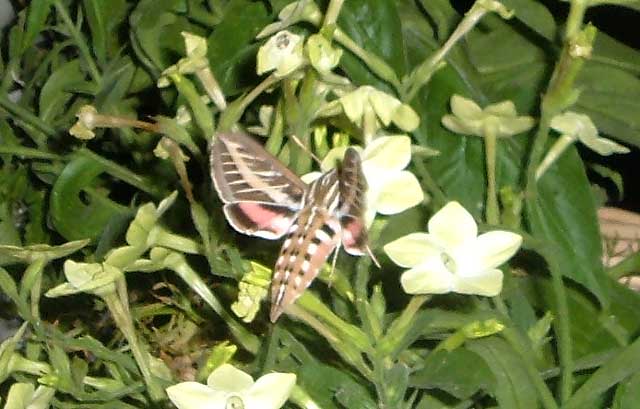
Hyles lineata, Vermilion, Alberta,
August 12, 2007, courtesy of Holly Holmen.
Holly writes, "Hello, We saw this moth about 9:30 at night feeding on petunias on the deck. So we took a picture and we think that it may
be of interest to you. We live north of Vermilion Alberta. Even though the picture is not too clear we think it may be a match to the
picture of a Hyles euphorbiae on your website. Is there any way you can confirm or deny? And how common are they in our area?
Also any other tid-bits of interest you can offer us would be appreciated."
Holly, it is Hyles lineata, a close relative of Hyles euphorbiae. The White-lined Sphinx, probably does not overwinter in your area, but
probably migrates, in relatively large numbers from the southwestern states each year and produces one to three broods in your area.
Robert Bercha confirms Hemaris diffinis in Gull Lake area with an image of a prepupal larva. Robert writes, "A friend of mine found this
caterpillar on August 14, 2011 near Gull Lake, Alberta. Possibly a sphinx moth caterpillar of some type?
Thought you might be interested."
I reply, "You are correct it is a Sphingidae larva, Hemaris diffinis, the Snowberry Clearwing
I request permission to post images from links on diffinis file and also on
Alberta Sphingidae page.
On August 18 Robert responds, "Thank you for your note back.
The caterpillar just pupated today.
I m guessing I need to put it into cold storage for a couple of weeks to get a moth?
Any suggestions on the best way to do this?
My thoughts and suggestions: "Because of the date and your location, this pupa may or may not yield a moth this summer. I would not put it into cold storage because
the larva may not have developed the enzyme needed to survive a prolonged chill. I suggest you give the pupa about four or five days for the pupal shell to harden
and then keep it in an emergence container as described in Care of Found Larvae/Caterpillars: Manduca sexta
August 21, 2008, Trina Woodall.
"If it has not eclosed by end of September, then would be the time to put it into cold storage for the winter months. In the spring you could then treat it as per the notes
on the same webpage linked above. Cold storage recommendations are also described on the same link. Please let me know what happens for future reference. The moth might eclose in as few as
two weeks from pupation date."

Hemaris diffinis prepupal larva, near Gull Lake, Alberta,
August 14, 2011, photo courtesy of Robert Bercha of larva found by friend.
Many thanks to Edna Woodward and to Jeremy Gatten. Edna alerted me to Jeremy's beautiful image of a Proserpinus flavofascata nectaring, and he granted me
permission to post below and to the flavofasciata file.

Proserpinus flavofasciata, Fort McMurray, Alberta,
June 1, 2014, courtesy of Jeremy Gatten.
I have created the thumbnail section below to make identifications easier.
Sphinginae subfamily
Sphingini tribe:
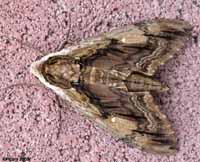 |
Ceratomia amyntor
SB, Elm; Four-horned Sphinx:
Forewing upperside is brown with dark brown and white markings including a white costal area near the wing base, dark
streaks along the veins, and a white spot in the cell. The upperside of the hindwing is light brown and has a dark brown
band along the outer margin.
|
 |
Ceratomia undulosa
ALG/EU,
Waved Sphinx:
The upperside of the forewing is pale brownish gray with wavy black and white
lines and a black-outlined white cell spot. |
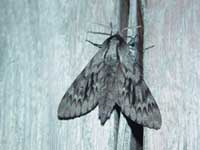 |
Lapara bombycoides
ALG, Northern Pine Sphinx:
The upperside of the forewing is gray with heavy black bands.
The upperside of the hindwing is brownish gray with no markings.
If you have pines, you
probably have this species. It also flies on P.E.I.
|
 |
Sphinx chersis
ALG/GH, the Northern Ash Sphinx or Great Ash Sphinx
The upperside of the forewing is soft dark gray to blue-gray
with a series of black dashes, one of which reaches the wing tip.
|
Sphinx chersis, July 6, 2008, Calgary, Alberta, Glenna Hauck
 |
Sphinx drupiferarum
ALG,
Wild Cherry Sphinx:
Forewings, long and slender, are held close to the body when the
moth is at rest. This moth is similar to Sphinx vashti.
|
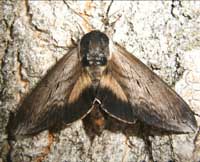 |
Sphinx luscitiosa
ALG,,
Canadian Sphinx or
Clemen's Sphinx.
FW upperside is yellowish gray in males and pale
gray with faint yellow tint in females. In both sexes, dark
border on the outer margin widens as it approaches inner margin.
HW upperside is deep yellow in males, pale yellow in
females; both with wide black border.
|
Sphinx luscitiosa, Beaverhill Lake, June 25, 2009, James Bailey
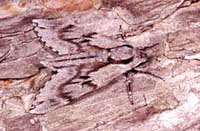 |
Sphinx pinastri ,
ALG, Pine Hawkmoth:
FW uppersides are gray with a gray-brown overlay.
There are black dashes near the center of the wing, and dark brown at
the base of the inner margin. HW upperside is
gray-brown with pale gray along the costal margin. HW is
darker than FW. rare
|
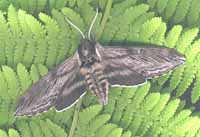 |
If you have blueberries in the woods, then you probably have the
Poecila Sphinx. They are probably widespread throughout Wisconsin,
but are very much under reported. |
 |
Sphinx vashti
ALG, Snowberry Sphinx:
Snowberry Sphinx adults fly as a single brood in montane woodlands and along prairie
streamcourses from April to August.
The upperside of the forewing has a narrow black subterminal line
bordered by a white inverted V-shaped line on the outside, and a
black line at the apex. |
Smerinthini Tribe:
 |
The outer margin of the forewing is quite wavy. There is a dark cell
spot and a dark oblique line mid wing from the costa almost to the
inner margin. Basic ground colour is pinkish brown. Flight would
be June-July. |
 |
Paonias myops
ALG,
the Small-eyed Sphinx
This species
ranges
across North America.
The hindwings have a small blue eyespot ringed with black on a
yellow background.
|
 |
Pachysphinx modesta
ALG,
the Modest Sphinx or Poplar Sphinx
Hindwings are reddish purple with dark blue near anal angle.
They are a heavy bodied species.
|
 |
Smerinthus cerisyi
ALG, the Cerisyi's Sphinx or One-eyed Sphinx, Larvae feed on poplars and willows.
Flight would be from late May-July as a single brood.
|
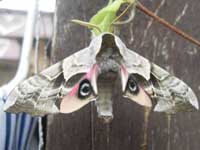 | Larvae feed on poplars, aspen and willows.
Note different shape of double arced forewing pm line compared to the straighter pm line of cerisyi, directly above.
S. ophthalmica has smoother scalloping of the fw outer margin.
|
 |
Smerinthus jamaicensis
ALG, the
Twin-spotted Sphinx:
Smerinthus jamaicensis closely resembles Smerinthus cerisyi, but
jamaicensis is much smaller with larger blue patches on more
vibrant and deeper purple in the lower wings.
|
Macroglossinae subfamily
Dilophonotini Tribe:
See Hemaris comparison to help distinguish
the next three species.
 |
Hemaris diffinis
ALG/GBR, the Snowberry Clearwing or Bumblebee Moth:
The moth flies along forest edges and in meadows, gardens and
brushy fields. Day-flying adults nectar at lantana, dwarf bush honeysuckle,
snowberry, orange hawkweed, thistles, lilac, Canada violet, etc. East of Continental Divide |
Hemaris diffinis Red Deer, May 17, 2013, G. Bruce Reid.
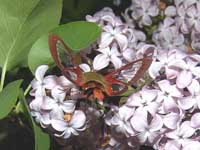 |
Hemaris gracilis
ALG, The Slender Clearwing or Graceful
Clearwing
This day flier is not commonly reported.
|
 |
Hemaris thysbe
ALG/SB, the Hummingbird Clearwing
It is not difficult to see why many gardeners would mistake an
Hemaris thysbe moth for a small hummingbird as it hovers, sipping nectar
from flowers through a long feeding tube. |
Hemaris thysbe, 27 km north of Lave Lake, June 13, 2009, Shawn Baker.
 |
Hemaris thetis WO, the Thetis Clearwing or Bee Hawk Moth.
The moth flies along forest edges and in meadows, gardens and
brushy fields. Day-flying adults nectar at lantana, dwarf bush honeysuckle,
snowberry, orange hawkweed, thistles, lilac, Canada violet, etc. It can be found west of the Continental Divide in southwestern
Alberta.
|
Macroglossini Tribe:
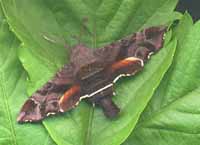 |
Amphion floridensis
ALG, the Nessus Sphinix:
This day flier is widely distributed. If you have Virginia Creeper,
you might have the Nessus Sphinx. Two bright, distinct, narrow
yellow bands are often visible on the abdomen.
|
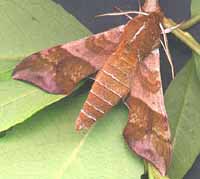 |
Darapsa choerilus
ALG,
the Azalea Sphinx:
They are common in New Jersey and common
here on Prince Edward Island.
You will often see this species listed as Darapsa pholus,
especially in older literature.
|
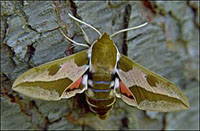 |
Hyles euphorbiae
ALG/bmb/JW, the Spurge Hawk Moth
The body is light brown with various white and dark brown
markings, while the wings have a conspicuous tan, brown, and pink or
red color pattern.
|
 |
Hyles gallii
ALG/JB, the Bedstraw Hawk Moth
or Gallium Sphinx:
This species is not reported in Sheboygan, but it has been recorded
in other eastern Wisconsin counties. I suspect it is present.
Some years I see them on P.E.I., some years, I do not.
|
 |
Hyles lineata
ALG/HH, the White-lined Sphinx:
Adults usually fly at dusk, during the night, and at dawn, but they
also fly during the day over a wide variety of open habitats
including deserts, suburbs, and gardens. |
 | Proserpinus flavofasciata adults fly from
April-June in meadows in coniferous forests. Adults fly during the
afternoon, nectaring from lilac, dandelion, cherry, etc.
|
Proserpinus flavofasciata, Fort McMurray, June 1, 2014, courtesy of Jeremy Gatten.
 |
The upperside of the forewing is pale gray-green with a deep
green-brown median area and a white dash at the wing tip.
|
|
|
Goto Alberta Sphingidae
Larvae Thumbnails.
Use your browser "Back" button to return to the previous page.
This page is brought to you by Bill Oehlke and the WLSS.
Please send sightings/images to Bill. I will do my best to respond to
requests for identification help.






